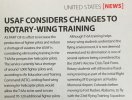My 2 cents:
3. The biggest difference in having a 2 engine mindset is single engine landings. Those can be simulated just like we simulate max gross weight. Hell, half the time in the fleet that's how we'd do it because people were pansies and wouldn't pull back an engine.
4. The bar at the HSC FRS is too low. They know this, so they added a bunch of events... but then didn't get the funding or what-have-you, so they push them to the fleet on waivers which must be completed when a CAT-1 shows up. The entire idea of a "fundamentals" syllabus in the fleet seems ridiculous to me. Most of the FRS aircraft aren't link-16 capable. A CAT-1 shows up to the fleet familiar with weapons, but not how to employ them, and knows enough to not kill him/herself overland day or night, but certainly not around the boat.
5. The bar at the HT's is probably too low. I think the current syllabus needs minor tweaking and lots of additions. Take out 2 BI flights and probably 1 of the 2 night unaided flights. Add NVG formation and have a larger academic energy management syllabus, with maybe even a FAM flight that HSC (at least used to) have. Remove ADF altogether, maybe even failed card. I swear we only teach failed card because the TH-57 is so liable to actually have failed card, not because the fleet is demanding its pilots know how to. There's

